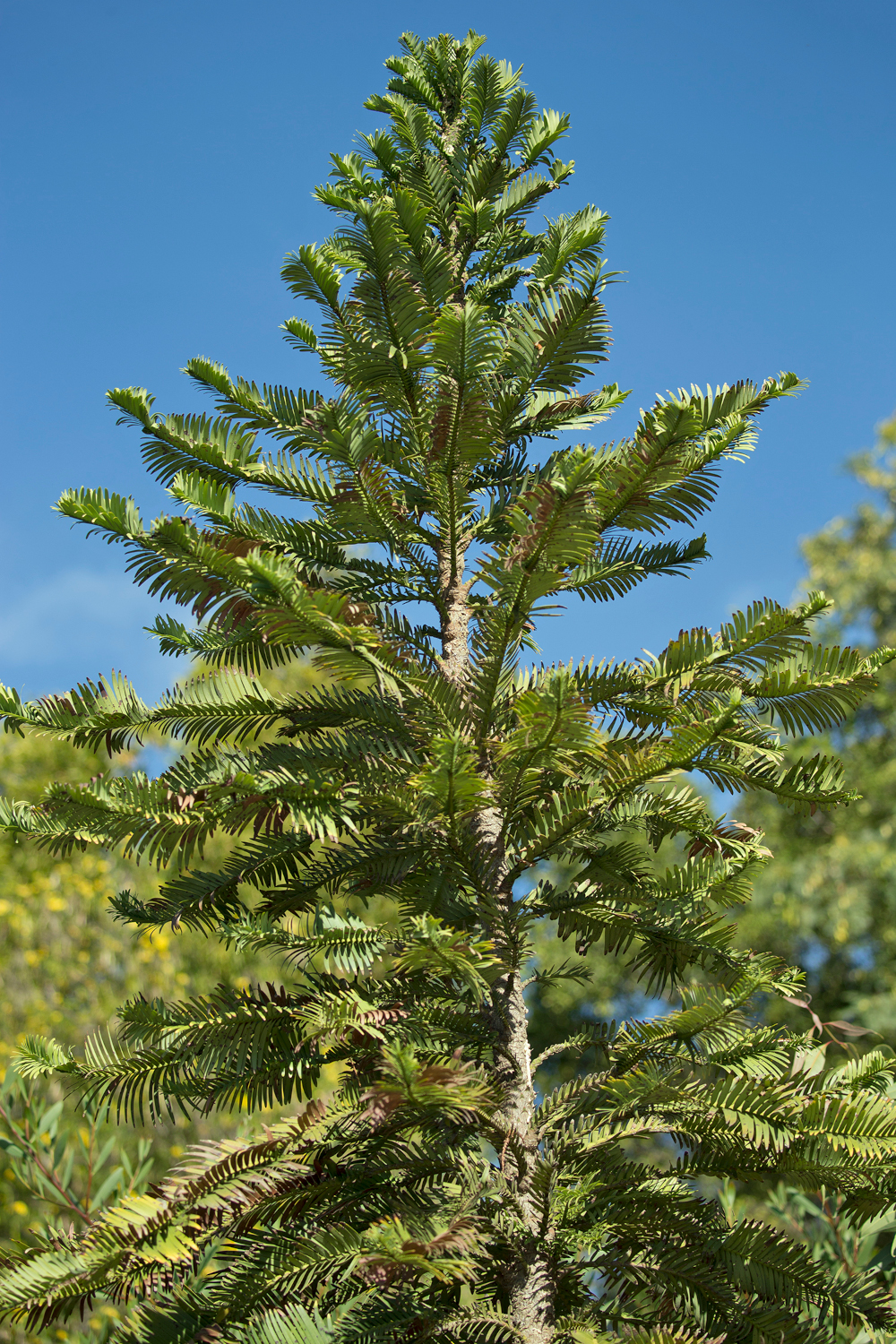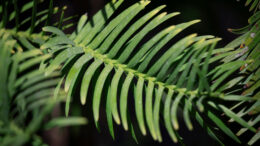Wollemi pines are among the rarest plants in the world, with fewer than 100 trees left in their native habitat. They were known only by fossil records until 1994, when a thicket of about 40 massive, conifer-type trees was discovered in Wollemi National Park, in Australia’s Blue Mountains.
Scientists quickly dug into identifying these then-unidentified trees, working in heavy secrecy to protect their location. Eventually they found fossil evidence in stone that matched the living trees — confirming that a tree species they had thought was extinct, in fact, still existed.
Since then, scientists and horticulturists have worked to ensure that this species survives. One way is through propagation techniques and growing the trees in gardens. It’s a slow process: The Wollemi pine has very controlled growth, sometimes taking up to 25 years to reach its first 20 feet in height.
Species name:
Wollemi pine (Wollemia nobilis)
Description:
With their tough, fern-type fronds and dark brown, oddly “bubbled” bark, Wollemi pines have a distinct, unusual look. They’re tall, coniferous trees with needle-like leaves, that can grow to 130 feet in height. Their trunks can reach up to three feet in diameter, and it’s common to find numerous trunks emerging from a single root base. Wollemi pines reproduce vegetatively and by wind pollination. They are monoecious plants, having both male and female cones on each tree, and extremely long-lived: Some trees in their native habitat are estimated to range from 500 to 1,000 years old.
Where it’s found:
The Wollemi pine is native to Wollemi National Park, west of Sydney in New South Wales, Australia, where it occurs along a creek, in a deep and sheltered sandstone gorge in the Blue Mountains.
IUCN Red List status:
Critically endangered
Major threats:
Their limited geographic distribution and small population size make Wollemi pines extremely vulnerable to disease and wildfire. Pathogens threatening the trees include Phytophthora cinnamomic, a mold that causes root rot, and Botryosphaeria, a group of disease-causing fungi species.
Notable conservation programs:
Wollemi pines are critically endangered, with their native populations scattered within isolated pockets of Wollemi National Park. The trees are protected through wildlife conservation efforts, and the locations of the wild groves are kept secret to prevent damage and disease introduction.
Their isolation doesn’t always protect them: The catastrophic Gospers Mountain megafire of 2020 burned more than 1.2 million acres and nearly destroyed the last remaining native populations of Wollemi pine. Luckily the Australian government noted the significance of these isolated forests and deployed a specialized team of firefighters to safeguard the cherished groves. In a coordinated effort, air tankers dropped fire retardant while crews on the ground set up irrigation systems to hydrate the environment. The strategy proved successful, and very few of the trees were consumed by the fire. Photos of the aftermath showed a desolate and charred landscape, with verdant pockets of Wollemi pines standing tall.
Outside of their protected locations, Wollemi pines grow in several horticultural facilities around the world — including San Diego Zoo Safari Park, which currently has two Wollemi pines and five more growing in propagation.

The San Diego Zoo Wildlife Alliance is also engaged in Australian plant conservation through our support of the Australian Network for Plant Conservation. Our funding helps support wildfire ecology and recovery research. The relationship began after the devasting Australian wildfires of 2019/2020.
It’s not just the professionals keeping these trees alive. Australian residents can order Wollemi pine seedlings to grow in their backyards, a unique conservation effort that helps ensure the species’ genetic viability.
My favorite experience:
I have never had the opportunity to see Wollemi pines thriving in their native habitat, but during a recent trip to Australia, I did have the opportunity to visit the Royal Botanic Gardens in Cranbourne, where I enjoyed discussing horticulture management best practices for these pines with the staff horticulturists. Their cultivation techniques have helped inform our own horticulture practices and provided clarity to some of our observations and experiences in San Diego.
What else do we need to understand or do to protect this species?
A combination of in situ protection along with ex situ cultivation helps safeguard this critically endangered species. There is also a considerable amount of collaborative plant science research on Wollemi pines occurring in academic, governmental and botanic garden settings. The research is predominantly focusing on:
-
- Understanding how the Wollemi pine grows in its native habitat, and in cultivation
- Investigating germination requirements and seed banking potential
- Banking seeds that can be conserved through seed banking, and developing alternative conservation measures
- Providing plants for display, interpretation and reintroduction
- Passing on lessons learned to the wider community.
Further reading:
“A Living Fossil” (San Diego Zoo Wildlife Alliance)
“If Trees Could Talk…” (The Royal Botanic Garden Sydney)
Do you live in or near a threatened habitat or community, or have you worked to study or protect endangered wildlife? Share your stories in our ongoing features, Protect This Place and Species Spotlight.
![]()


